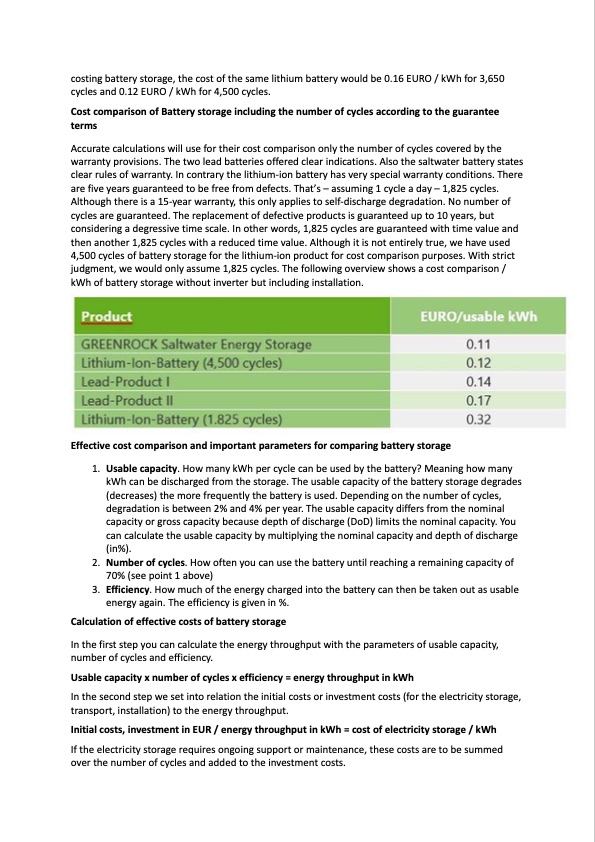
PDF Publication Title:
Text from PDF Page: 003
costing battery storage, the cost of the same lithium battery would be 0.16 EURO / kWh for 3,650 cycles and 0.12 EURO / kWh for 4,500 cycles. Cost comparison of Battery storage including the number of cycles according to the guarantee terms Accurate calculations will use for their cost comparison only the number of cycles covered by the warranty provisions. The two lead batteries offered clear indications. Also the saltwater battery states clear rules of warranty. In contrary the lithium-ion battery has very special warranty conditions. There are five years guaranteed to be free from defects. That’s – assuming 1 cycle a day – 1,825 cycles. Although there is a 15-year warranty, this only applies to self-discharge degradation. No number of cycles are guaranteed. The replacement of defective products is guaranteed up to 10 years, but considering a degressive time scale. In other words, 1,825 cycles are guaranteed with time value and then another 1,825 cycles with a reduced time value. Although it is not entirely true, we have used 4,500 cycles of battery storage for the lithium-ion product for cost comparison purposes. With strict judgment, we would only assume 1,825 cycles. The following overview shows a cost comparison / kWh of battery storage without inverter but including installation. Effective cost comparison and important parameters for comparing battery storage 1. Usable capacity. How many kWh per cycle can be used by the battery? Meaning how many kWh can be discharged from the storage. The usable capacity of the battery storage degrades (decreases) the more frequently the battery is used. Depending on the number of cycles, degradation is between 2% and 4% per year. The usable capacity differs from the nominal capacity or gross capacity because depth of discharge (DoD) limits the nominal capacity. You can calculate the usable capacity by multiplying the nominal capacity and depth of discharge (in%). 2. Number of cycles. How often you can use the battery until reaching a remaining capacity of 70% (see point 1 above) 3. Efficiency. How much of the energy charged into the battery can then be taken out as usable energy again. The efficiency is given in %. Calculation of effective costs of battery storage In the first step you can calculate the energy throughput with the parameters of usable capacity, number of cycles and efficiency. Usable capacity x number of cycles x efficiency = energy throughput in kWh In the second step we set into relation the initial costs or investment costs (for the electricity storage, transport, installation) to the energy throughput. Initial costs, investment in EUR / energy throughput in kWh = cost of electricity storage / kWh If the electricity storage requires ongoing support or maintenance, these costs are to be summed over the number of cycles and added to the investment costs.PDF Image | new generation of saltwater batteries

PDF Search Title:
new generation of saltwater batteriesOriginal File Name Searched:
Dr-Thomas-F-Krausse-BlueSky-Energy-paper.pdfDIY PDF Search: Google It | Yahoo | Bing
Product and Development Focus for Salgenx
Redox Flow Battery Technology: With the advent of the new USA tax credits for producing and selling batteries ($35/kW) we are focussing on a simple flow battery using shipping containers as the modular electrolyte storage units with tax credits up to $140,000 per system. Our main focus is on the salt battery. This battery can be used for both thermal and electrical storage applications. We call it the Cogeneration Battery or Cogen Battery. One project is converting salt (brine) based water conditioners to simultaneously produce power. In addition, there are many opportunities to extract Lithium from brine (salt lakes, groundwater, and producer water).Salt water or brine are huge sources for lithium. Most of the worlds lithium is acquired from a brine source. It's even in seawater in a low concentration. Brine is also a byproduct of huge powerplants, which can now use that as an electrolyte and a huge flow battery (which allows storage at the source).We welcome any business and equipment inquiries, as well as licensing our flow battery manufacturing.| CONTACT TEL: 608-238-6001 Email: greg@salgenx.com | RSS | AMP |